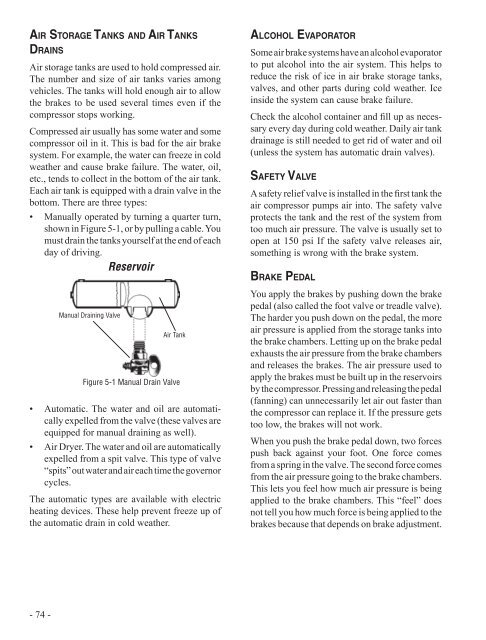Commercial Driver Handbook ( PDF ) - California Department of ...
Commercial Driver Handbook ( PDF ) - California Department of ...
Commercial Driver Handbook ( PDF ) - California Department of ...
Create successful ePaper yourself
Turn your PDF publications into a flip-book with our unique Google optimized e-Paper software.
air storage tanks and air tanks<br />
drains<br />
Air storage tanks are used to hold compressed air.<br />
The number and size <strong>of</strong> air tanks varies among<br />
vehicles. The tanks will hold enough air to allow<br />
the brakes to be used several times even if the<br />
compressor stops working.<br />
Compressed air usually has some water and some<br />
compressor oil in it. This is bad for the air brake<br />
system. For example, the water can freeze in cold<br />
weather and cause brake failure. The water, oil,<br />
etc., tends to collect in the bottom <strong>of</strong> the air tank.<br />
Each air tank is equipped with a drain valve in the<br />
bottom. There are three types:<br />
• Manually operated by turning a quarter turn,<br />
shown in Figure 5-1, or by pulling a cable. You<br />
must drain the tanks yourself at the end <strong>of</strong> each<br />
day <strong>of</strong> driving.<br />
Reservoir<br />
• Automatic. The water and oil are automatically<br />
expelled from the valve (these valves are<br />
equipped for manual draining as well).<br />
• Air Dryer. The water and oil are automatically<br />
expelled from a spit valve. This type <strong>of</strong> valve<br />
“spits” out water and air each time the governor<br />
cycles.<br />
The automatic types are available with electric<br />
heating devices. These help prevent freeze up <strong>of</strong><br />
the automatic drain in cold weather.<br />
- 74 -<br />
Manual Draining Valve<br />
Air Tank<br />
Figure 5-1 Manual Drain Valve<br />
alCohol evaporator<br />
Some air brake systems have an alcohol evaporator<br />
to put alcohol into the air system. This helps to<br />
reduce the risk <strong>of</strong> ice in air brake storage tanks,<br />
valves, and other parts during cold weather. Ice<br />
inside the system can cause brake failure.<br />
Check the alcohol container and fill up as necessary<br />
every day during cold weather. Daily air tank<br />
drainage is still needed to get rid <strong>of</strong> water and oil<br />
(unless the system has automatic drain valves).<br />
safety valve<br />
A safety relief valve is installed in the first tank the<br />
air compressor pumps air into. The safety valve<br />
protects the tank and the rest <strong>of</strong> the system from<br />
too much air pressure. The valve is usually set to<br />
open at 150 psi If the safety valve releases air,<br />
something is wrong with the brake system.<br />
Brake pedal<br />
You apply the brakes by pushing down the brake<br />
pedal (also called the foot valve or treadle valve).<br />
The harder you push down on the pedal, the more<br />
air pressure is applied from the storage tanks into<br />
the brake chambers. Letting up on the brake pedal<br />
exhausts the air pressure from the brake chambers<br />
and releases the brakes. The air pressure used to<br />
apply the brakes must be built up in the reservoirs<br />
by the compressor. Pressing and releasing the pedal<br />
(fanning) can unnecessarily let air out faster than<br />
the compressor can replace it. If the pressure gets<br />
too low, the brakes will not work.<br />
When you push the brake pedal down, two forces<br />
push back against your foot. One force comes<br />
from a spring in the valve. The second force comes<br />
from the air pressure going to the brake chambers.<br />
This lets you feel how much air pressure is being<br />
applied to the brake chambers. This “feel” does<br />
not tell you how much force is being applied to the<br />
brakes because that depends on brake adjustment.

















